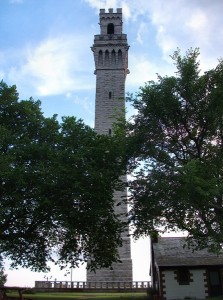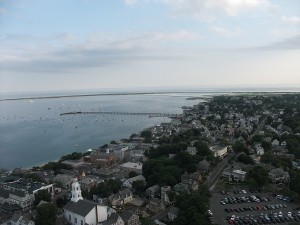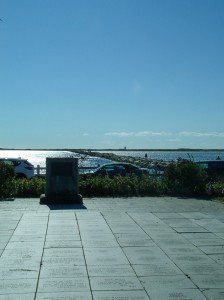PROVINCETOWN – The year 1620 is etched in the annals of world history. It is the year that a group of English settlers known as the Pilgrims seeking religious freedom boarded their ship, Mayflower, and braved a hazardous trip across the Atlantic Ocean to establish a new home.
But though many in this country know the story of the Mayflower, some might be confused about where the band of Pilgrims landed.
Many people would likely say that the Pilgrims landed at a spot to be known as Plymouth. True, the Pilgrims did land at Plymouth, dubbing it originally ‘New Plymouth,” since they departed from Plymouth, England.
But Plymouth was not the Pilgrims’ first landing spot in the New World.
Five weeks before coming ashore in Plymouth, the Pilgrims docked in at what is today Provincetown Harbor. In fact, the first written document alluding to government in the new colony, the Mayflower Compact, was signed by 41 Pilgrims while still aboard the ship in Provincetown Harbor.

The Provincetown Monument commemorates the Pilgrim’s first landing place at the Cape’s tip.
On November 11, 1620, the Pilgrims came ashore on land that is now in Provincetown on Cape Cod. The booklet, Mourt’s Relation, written mostly by Edward Winslow who would become the third governor of Plymouth Colony, shows a map of where the first steps on land were supposed to have taken place.
The landing place is commemorated with a plaque and a small park located in the middle of the rotary at the end of Commercial Street. It is appropriately called ‘Pilgrims’ First Landing Park.’
On a typical drive through the packed streets of Provincetown today it is very easy to miss this spot. It is partially obscured by bushes and trees.
Nearby, there is a view of the West End Breakwater stretching out across the harbor to Long Point. It is no wonder why many visitors have no idea that such an important piece of history stands before them.
Although First Landing Park is a somewhat understated tribute to the Pilgrims’ landing at Provincetown, there is another, much larger, tribute which is one of the most well known landmarks on the entire Cape.

The view from the top of the Pilgrim Monument.
Pilgrim Monument stands 252 feet tall and is made of solid granite. In addition it stands atop the nearly one hundred foot High Pole Hill bringing it to a grand total of approximately 350 feet above sea level.
Construction of the monument was begun in 1907 with the cornerstone being laid under the watch of President Theodore Roosevelt. He gave a rousing speech before returning to his home on Long Island aboard the presidential yacht which was also named Mayflower.
The monument was completed in 1910 and dedicated by President William Taft on August 5 of that year.
Inside the monument are 116 steps and sixty ramps leading to the observation deck and possibly the best view on Cape Cod.
To the southeast sits the very harbor where the Mayflower docked nearly 400 years ago. From that height it feels as though one is looking down from a cloud. There are Provincetown’s many historic homes, churches and shops. Looking southwest are the coastlines of Truro, Wellfleet and beyond. Binoculars are provided.
The architecture of the monument is modeled after the Torre del Mangia, built in Siena in the Tuscany region of Italy. This tower was built in the mid-14th century and is made from stone, brick, and marble.

First Landing Park in Provincetown overlooks the West End Breakwater, Long Point and Provincetown Harbor.
Ironically the Pilgrim Monument bears no resemblance on the outside to anything to do with the famous English colonists. But inside set into the walls of the tower, there are many stone markers celebrating the towns of Massachusetts and mentioning the Mayflower Compact.
After five weeks exploring Cape Cod from Provincetown to Eastham, historians report that the Pilgrims got into a skirmish with the Nauset tribe of Native Americans and decided they might be better off settling in another location.
They left Provincetown and landed at Plymouth on December 16, 1620. The spot where Plymouth Rock currently sits under a beautiful Italian-style portico is purported to be only a few hundred feet from where the original Pilgrim settlement was created.
The history of the New World, the colonies, and the United States might usually begin with a mention of the Mayflower docking at Plymouth Harbor. But the Pilgrims first steps in the New World and the signing of The Mayflower Compact took place in Provincetown.
The Pilgrim Monument, First Landing Park, and several other historic Pilgrim-related sites are reminders that the Pilgrims left their first footprints on Cape Cod.
For more on the Pilgrims’ time on Cape Cod check out this YouTube Video below:
If You Go: Pilgrim First Landing Park – Rotary which intersects Province Lands Road and Commercial Street.
Pilgrim Monument – High Pole Hill Road, Provincetown
Chris Setterlund, who lives in Yarmouth, is a lifelong Cape Codder and the author of In My Footsteps, a guide to historical sites on Cape Cod.























